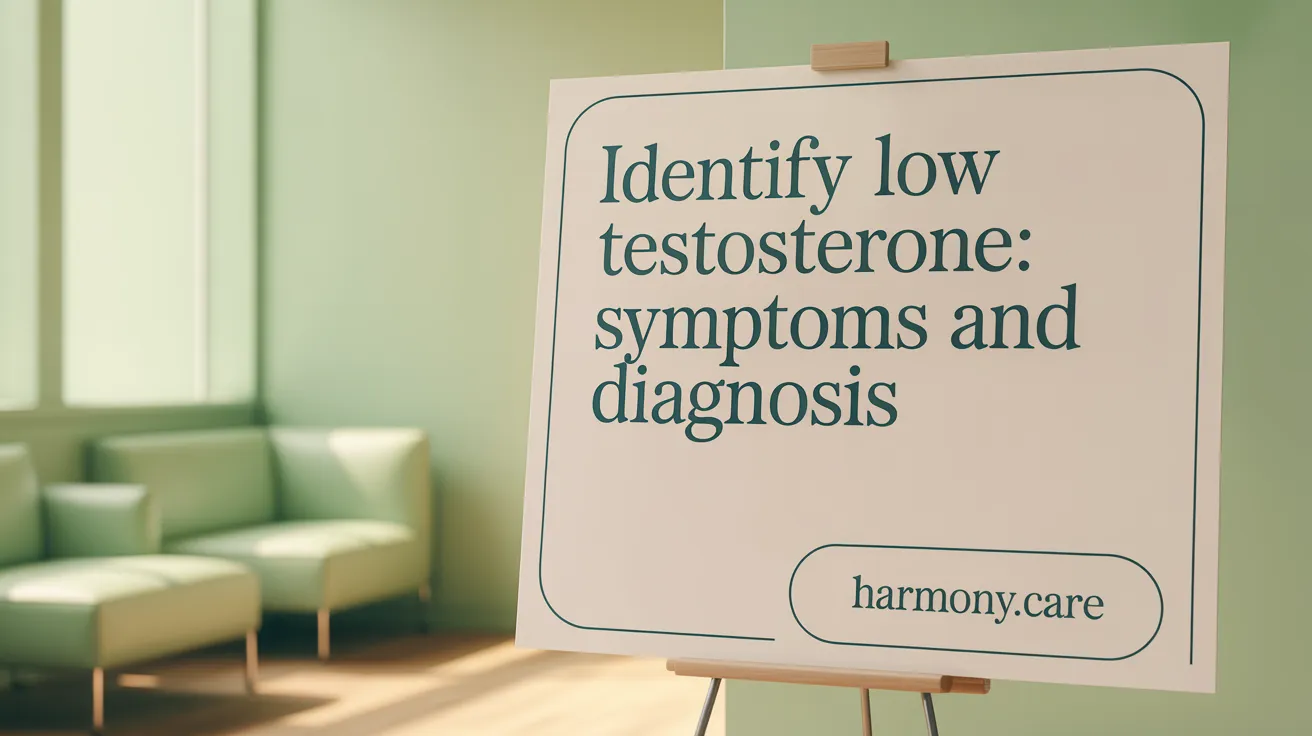Understanding Modern Testosterone Treatments
Men's hormone therapy has evolved significantly in recent years with advancements in diagnosis, treatment options, and safety monitoring. Testosterone replacement therapy (TRT) remains central to managing hypogonadism and associated symptoms like low energy, diminished libido, and muscle loss. This article navigates the latest developments and considerations in men's hormone therapy, highlighting various delivery methods, emerging treatments, benefits, and risks to inform men and healthcare providers alike.
Diagnosis and Indications for Testosterone Therapy

What symptoms indicate the need for testosterone therapy?
Men with low testosterone often experience symptoms such as decreased libido, erectile dysfunction, fatigue, decreased muscle mass, depression, difficulties with concentration, and increased body fat. These signs suggest potential hypogonadism and warrant medical evaluation. For more information on Symptoms of low testosterone and Symptoms of low testosterone in men, see these resources.
How is low testosterone diagnosed?
Diagnosis relies on blood tests performed in the morning, measuring total testosterone along with free and bioavailable testosterone levels. Reference ranges generally define total testosterone as normal between 12.1–33 nmol/L (approximately 300 ng/dL to 900 ng/dL). It is advised to confirm low testosterone with at least two separate morning tests due to natural daily fluctuations. Additional tests may assess related hormones and overall health. Learn more about Blood tests for diagnosing low testosterone, Testosterone reference ranges, and Male hypogonadism diagnosis.
When is testosterone therapy recommended?
Testosterone replacement therapy is considered for men who have both consistent symptoms of low testosterone and blood results confirming levels below 300 ng/dL, after ruling out other causes. TRT is generally not recommended solely for the natural age-related decline in testosterone, which commonly begins around age 30–40 and progresses gradually. Clinical guidelines emphasize careful evaluation and exclusion of contraindications before initiating therapy to ensure benefits outweigh potential risks. Read about Criteria for considering TRT, Age-related testosterone decline, and Testosterone Replacement Therapy overview for more details.
Forms of Testosterone Replacement Therapy and Administration Routes

What are the available methods of testosterone administration?
Testosterone replacement therapy (TRT) offers several administration routes tailored to patient preferences and medical needs. Common methods include:
- Intramuscular injections: Testosterone cypionate and enanthate are injected weekly or every few weeks, providing short-to-medium duration effects. Testosterone undecanoate is a long-acting injectable dosed roughly every 10 weeks.
- Transdermal gels and patches: Applied daily to the skin, these allow consistent hormone absorption with easy dose adjustments. They are popular due to non-invasive delivery.
- Subcutaneous pellets: Implanted under the skin, pellets release testosterone steadily over 3 to 6 months, requiring fewer maintenance visits.
- Buccal tablets and nasal gels: These deliver testosterone via mucous membranes, offering alternative options for those who prefer avoiding injections or skin applications.
- Oral capsules: New oral soft gel formulations like Kyzatrex use lymphatic absorption to bypass liver metabolism, improving bioavailability and maintaining physiological levels.
How do administration methods differ?
Each TRT form varies by administration frequency, absorption, and patient convenience:
| Method | Frequency | Delivery Features |
|---|---|---|
| Testosterone cypionate | Weekly or every 2-4 weeks | Intramuscular; variable hormone peaks |
| Testosterone enanthate | Weekly or every 2-4 weeks | Intramuscular; similar to cypionate |
| Testosterone undecanoate | Every 10 weeks | Long-acting injection; steadier levels |
| Gels and patches | Daily | Transdermal; steady absorption |
| Pellets | Every 3–6 months | Subcutaneous; long sustained release |
| Buccal tablets | Twice daily | Mucosal absorption; non-invasive |
| Nasal gels | Multiple daily doses | Fast absorption; alternative delivery |
| Oral capsules (Kyzatrex) | Daily | Lymphatic absorption; avoids liver |
Tailoring therapy to patient needs
Selection of TRT method considers lifestyle, comorbidities, convenience, cost, and side effect profiles. For example, long-acting injections reduce dosing frequency, while gels and patches may appeal to those avoiding needles. Oral formulations provide an option for patients seeking ease of dosing without injections or skin application. Pellets benefit patients desiring minimal adherence effort, releasing hormone steadily over months.
Healthcare providers customize the treatment, balancing effectiveness and tolerability while regularly monitoring hormone levels and side effects to optimize therapy.
Emerging Innovations and Trends in Testosterone Therapy

What are the latest advancements in testosterone therapy?
Recent developments in testosterone replacement therapy (TRT) have introduced several novel drug formulations and delivery methods aimed at improving efficacy, patient convenience, and safety. Among these, long-acting injectable testosterone undecanoate has gained prominence for providing stable, physiological serum testosterone levels with less frequent dosing. Additionally, new oral soft gel capsules like Kyzatrex are designed to bypass liver metabolism by absorption through the lymphatic system, offering high bioavailability and steady hormone levels. Nasal gels that permit rapid testosterone absorption provide another alternative, enabling more flexible dosing schedules.
Are there therapies that stimulate natural testosterone production?
Apart from direct testosterone supplementation, recent therapeutic advancements include medications that boost the body's own testosterone synthesis. Clomiphene citrate and enclomiphene are agents that stimulate endogenous testosterone production by modulating the hypothalamic-pituitary-gonadal axis. These treatments are particularly valuable for men wishing to preserve fertility, as they avoid the suppression of sperm production associated with exogenous testosterone use.
How are treatment approaches becoming more personalized?
Individualized treatment is an emerging focus in testosterone therapy, with clinicians considering patient preferences, comorbidities, and lifestyle factors. Innovations such as microdosing and advanced transdermal systems aim to enhance patient compliance while minimizing side effects. Selection among injectable, oral, nasal, or transdermal formulations is optimized based on medical needs and monitoring requirements, reflecting a personalized medicine approach.
These innovations collectively enhance the therapeutic landscape for men with testosterone deficiency, offering safer, more effective, and patient-friendly options for hormone replacement.
Clinical Benefits of Testosterone Replacement Therapy

What benefits does testosterone therapy provide?
Testosterone replacement therapy (TRT) supports a range of improvements in men diagnosed with hypogonadism or clinically low testosterone levels. It notably enhances sexual desire and erectile function, which are often impaired with testosterone deficiency. Many men report an increase in libido and more frequent sexual activity following treatment.
Muscle mass and bone density also benefit significantly from TRT. Testosterone promotes anabolic effects increasing lean body mass and strengthening bones, lowering the risk of fractures in aging men. Improvements in muscle strength and mass can be observed within weeks to months of therapy initiation.
Mood and energy levels generally show positive shifts with testosterone therapy. Many patients experience better overall well-being, reduced depressive symptoms, and increased vitality. Cognitive aspects such as mental focus and concentration may improve, although evidence for cognitive enhancement is more limited.
Can testosterone therapy affect metabolic health?
TRT plays a role in metabolic regulation by improving insulin sensitivity, glycemic control, and lipid profiles. This is particularly important for men with or at risk for type 2 diabetes and metabolic syndrome, where testosterone therapy may help prevent or induce remission of diabetes.
Additionally, TRT can reduce body fat, particularly abdominal fat, contributing to better cardiovascular risk profiles. While the therapy generally does not increase the risk of major adverse cardiac events, it requires careful monitoring due to some associations with increased red blood cell count and potential clotting risks (sources with clinical trial data, cardiovascular safety).
Overall, testosterone therapy offers multifaceted clinical benefits beyond reproductive health, extending into metabolic and cardiovascular domains, particularly when administered under appropriate medical supervision and tailored to individual patient needs.
Safety Considerations and Contraindications in TRT

What are the main safety concerns with testosterone therapy?
Testosterone replacement therapy (TRT) carries several safety considerations. It may stimulate benign prostatic hypertrophy (BPH), leading to prostate enlargement symptoms. Although TRT does not cause prostate cancer, it can potentially stimulate the growth of existing prostate cancer. TRT may also worsen sleep apnea in susceptible men. Another major concern is polycythemia, an increase in red blood cell count, which raises the risk of blood clots that can cause serious cardiovascular events. Mood changes including irritability and depression may also occur.
Does testosterone therapy increase cardiovascular risks?
Concerns have been raised about cardiovascular risks from TRT, but recent large, well-conducted studies give a clearer picture. The TRAVERSE trial, involving over 5,200 men aged 45-80 with low testosterone and cardiovascular risks, showed no increase in heart attack, stroke, or cardiovascular death risk compared to placebo. However, a slight increase in atrial fibrillation and blood clot events was noted. Men with congestive heart failure should be monitored carefully during TRT. Overall, TRT's cardiovascular safety appears acceptable with proper oversight (2023 New England Journal testosterone study, testosterone therapy safe for heart health.
Who should avoid testosterone therapy?
Certain conditions contraindicate TRT. Men with untreated prostate or breast cancer should avoid therapy due to risk of hormone stimulation of tumors (Hormone therapy for prostate cancer). Patients with severe congestive heart failure or uncontrolled obstructive sleep apnea are also at higher risk of complications and generally should not start TRT. Recent major cardiovascular events like heart attack or stroke within the past 3-6 months typically preclude starting testosterone therapy.
Monitoring hematocrit and red blood cell count
TRT often increases hemoglobin and hematocrit levels, reflecting stimulated red blood cell production (Blood tests for diagnosing low testosterone). Elevated hematocrit can thicken blood and lead to clot formation. Regular blood tests are essential to monitor these values. If levels become too high, dose adjustments or temporary discontinuation may be necessary to reduce clotting risk.
| Safety Aspect | Details | Clinical Implications |
|---|---|---|
| Prostate Health | May worsen BPH; caution in existing prostate cancer | Monitor PSA, digital rectal exam regularly |
| Cardiovascular Safety | No increased heart attack or stroke risk in studies | Watch for arrhythmias and clotting events (TRAVERSE trial overview) |
| Sleep Apnea | Can exacerbate symptoms | Evaluate and manage apnea prior to TRT (Health risks of testosterone therapy) |
| Polycythemia (RBC count) | TRT can raise hematocrit and hemoglobin | Regular blood counts needed; adjust therapy (Risks of testosterone replacement therapy) |
| Contraindications | Untreated prostate/breast cancer, severe heart failure, recent CV events, uncontrolled sleep apnea | Avoid TRT in these patients (Testosterone replacement therapy overview) |
Side Effects and Management During Testosterone Therapy
What side effects are commonly seen during TRT?
Testosterone replacement therapy (TRT) can lead to several side effects that patients may experience. Commonly reported issues include acne and skin irritation at the application site, especially with topical gels and patches. Fluid retention may also occur, causing swelling in the ankles or other areas.
Additionally, breast tissue changes such as gynecomastia (breast enlargement and tenderness) can happen due to hormonal shifts during treatment. Some men experience worsening sleep apnea symptoms or develop this condition anew. TRT may cause testicular shrinkage and decreased sperm production, which are important considerations for those concerned with fertility.
How does TRT affect male fertility?
TRT suppresses the body's natural sperm production by lowering endogenous testosterone and interfering with spermatogenesis. This suppression can lead to temporary or sometimes prolonged infertility. Men undergoing TRT who plan to father children should consult fertility specialists before starting therapy to explore options such as sperm banking. See more about fertility impact and preservation options.
Recovery of sperm production after stopping TRT varies but may take up to two years. Because of this significant impact, fertility considerations are a crucial part of treatment planning.
What happens when TRT is stopped?
When TRT is discontinued, testosterone levels usually return to pre-treatment baselines. Consequently, symptoms of low testosterone, such as fatigue, low libido, decreased muscle mass, and mood disturbances, frequently recur. For this reason, gradual weaning under medical supervision is recommended to mitigate symptom rebound and to closely monitor the patient's well-being. Learn more about TRT discontinuation and effects.
Regular follow-up testing and consultations can help manage side effects, adjust therapy doses, or decide on alternative treatments if necessary. Close collaboration with healthcare providers ensures safety and maximizes benefits while minimizing risks during and after TRT.
Long-Term Monitoring and Clinical Follow-up
How should patients be monitored during TRT?
To ensure safety and effectiveness, patients undergoing testosterone replacement therapy (TRT) require comprehensive and ongoing clinical monitoring. This includes regular blood tests to measure serum testosterone levels, allowing dose adjustments to maintain physiological ranges without overdosing.
PSA and prostate health surveillance
Prostate-specific antigen (PSA) tests are essential during TRT as testosterone can slightly increase prostate size and PSA levels. Continuous PSA monitoring helps detect any abnormal rises, which might signal prostate cancer progression or benign prostatic hypertrophy worsening. Elevated PSA levels warrant further clinical evaluation, such as digital rectal exams or imaging.
Monitoring hematocrit and liver function
TRT often increases red blood cell production, so hematocrit and hemoglobin levels are regularly checked to prevent complications like polycythemia, which can cause blood clots and hypertension. Liver function tests are also part of routine surveillance to detect any hepatic side effects, especially with oral testosterone formulations.
Adjusting therapy based on response and side effects
Clinical follow-up includes symptom review and side effect assessment. Adjustments to therapy—such as altering the dose or switching delivery methods—may be necessary if adverse effects like skin irritation, mood changes, or cardiovascular symptoms arise. Regular physical exams complement laboratory monitoring to optimize patient outcomes, as recommended by medical guidelines for testosterone replacement therapy.
Special Populations and Considerations in Hormone Therapy
How does hormone therapy differ in older men?
In older men, testosterone levels decline gradually starting around age 30 to 40, with common reductions of about 1% per year. This age-related testosterone decline often presents distinct clinical challenges. Testosterone replacement therapy (TRT) in this group has demonstrated benefits such as improved muscle strength, increased bone mineral density—especially in the lumbar spine—and enhanced sexual function including libido and erectile performance.
However, older men often carry a higher baseline risk for cardiovascular disease, necessitating careful assessment and ongoing monitoring during TRT. Studies have generally shown no significant increase in major adverse cardiovascular events with TRT when managed properly, but vigilance for risks such as atrial fibrillation and increased red blood cell count is important (Testosterone therapy safe for heart health, Testosterone replacement therapy cardiac safety study).
What influence do obesity and diabetes have?
Obesity profoundly affects testosterone dynamics by decreasing levels of sex hormone-binding globulin (SHBG), which reduces the bioavailability of testosterone in the bloodstream. Additionally, diabetes mellitus often complicates testosterone deficiency by contributing to erectile dysfunction and impairing metabolic control.
TRT in men with obesity and diabetes has shown promise in improving insulin sensitivity, reducing body fat, and enhancing lipid profiles. Clinical evidence supports the use of testosterone therapy to help prevent the progression from prediabetes to type 2 diabetes in hypogonadal patients, although patient selection and monitoring are critical to optimize outcomes (TRT effects on type II diabetes mellitus, TRT and glycemic control).
Is hormone therapy used in gender-affirming care?
Yes. Masculinizing hormone therapy plays a central role in gender-affirming care for transgender men and nonbinary individuals seeking masculinization. It involves administration of testosterone through injections, gels, patches, or pellets to induce desired physical changes.
These changes include cessation of menstruation, voice deepening, increased facial and body hair, redistribution of body fat, and increased muscle mass. Therapy requires careful monitoring due to potential risks such as weight gain, acne, sleep apnea, changes in lipid profiles, and fertility impact—including potential permanent infertility with prolonged use (Physical changes from testosterone, Fertility impact of masculinizing hormone therapy).
Care protocols also recommend ongoing evaluation of metabolic parameters, bone health, and appropriate cancer screenings as part of comprehensive management (Monitoring during TRT, Support systems for testosterone therapy.
This section has highlighted important considerations in hormone therapy tailored to special population groups, emphasizing the need for individualized, closely supervised treatment approaches (Hormone Replacement Therapy for Men, Testosterone Replacement Therapy overview.
Cost, Access, and Patient-Centered Approaches in TRT
What factors influence the cost of testosterone therapy?
The cost of testosterone replacement therapy (TRT) is influenced by several factors including the type of therapy used—such as injections, gels, or pellets—as well as the geographic location and healthcare provider. Insurance coverage also plays a significant role, with out-of-pocket expenses varying widely. Typical costs can range from a few hundred to over a thousand dollars for initial evaluation and ongoing treatment periods. For a detailed overview, see Costs of testosterone replacement therapy.
How is access to TRT evolving?
Access to testosterone therapy has expanded notably with the rise of telemedicine and at-home testosterone testing kits. These technologies offer convenience and broader reach for patients, allowing them to consult healthcare providers virtually and conduct preliminary hormone level assessments from home. However, this shift raises concerns about ensuring accurate diagnosis and the adequacy of monitoring in remote or less supervised settings. For more on monitoring and safety, refer to Medical supervision during TRT and Monitoring during TRT.
Why is patient-centered care important?
Patient-centered care in TRT emphasizes tailoring treatment to individual needs, preferences, and health conditions. Decisions about the form and dosage of testosterone are made considering factors like patient comfort with application methods, existing health issues, likelihood of adherence, and side effect risks. This approach aims to optimize treatment effectiveness while minimizing adverse effects, supporting a more sustainable and personalized hormone therapy experience. See Hormone therapy for men: Benefits and risks, Personalized TRT Treatment Options, and Medical supervision and prescription guidelines for TRT for further insights.
Navigating the Future of Men's Hormone Therapy
Men's hormone therapy continues to advance toward safer, more effective, and personalized approaches. With a suite of emerging treatment options from long-acting injections to novel oral formulations, men with hypogonadism or related conditions now have tailored therapies that suit their lifestyles and health needs. While testosterone replacement therapy offers meaningful benefits in sexual function, mood, muscle and bone health, comprehensive medical evaluation and vigilant monitoring remain essential to minimize risks and optimize outcomes. Through careful diagnosis, individualized treatment planning, and ongoing research, men's hormone therapy will increasingly support healthy aging and overall well-being with greater confidence and precision.
